语音学和音系学考试资料
- 格式:doc
- 大小:44.50 KB
- 文档页数:9
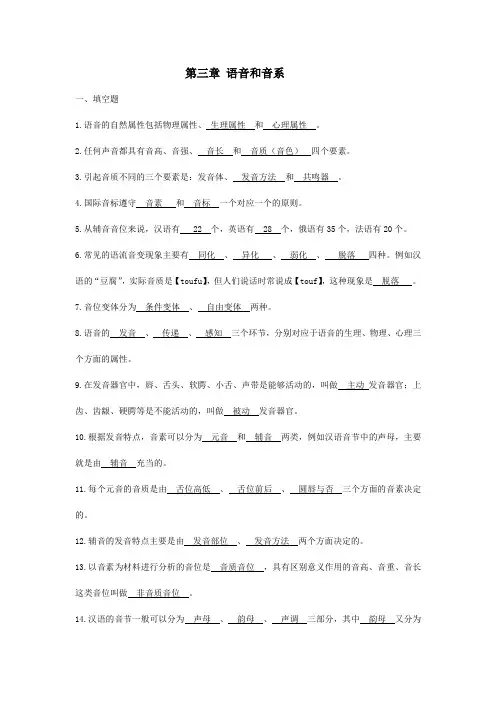
第三章语音和音系一、填空题1.语音的自然属性包括物理属性、生理属性和心理属性。
2.任何声音都具有音高、音强、音长和音质(音色)四个要素。
3.引起音质不同的三个要素是:发音体、发音方法和共鸣器。
4.国际音标遵守音素和音标一个对应一个的原则。
5.从辅音音位来说,汉语有 22 个,英语有 28 个,俄语有35个,法语有20个。
6.常见的语流音变现象主要有同化、异化、弱化、脱落四种。
例如汉语的“豆腐”,实际音质是【toufu】,但人们说话时常说成【touf】,这种现象是脱落。
7.音位变体分为条件变体、自由变体两种。
8.语音的发音、传递、感知三个环节,分别对应于语音的生理、物理、心理三个方面的属性。
9.在发音器官中,唇、舌头、软腭、小舌、声带是能够活动的,叫做主动发音器官;上齿、齿龈、硬腭等是不能活动的,叫做被动发音器官。
10.根据发音特点,音素可以分为元音和辅音两类,例如汉语音节中的声母,主要就是由辅音充当的。
11.每个元音的音质是由舌位高低、舌位前后、圆唇与否三个方面的音素决定的。
12.辅音的发音特点主要是由发音部位、发音方法两个方面决定的。
13.以音素为材料进行分析的音位是音质音位,具有区别意义作用的音高、音重、音长这类音位叫做非音质音位。
14.汉语的音节一般可以分为声母、韵母、声调三部分,其中韵母又分为韵头、韵腹、韵尾三部分。
15.汉语的调位可以分为阴平、阳平、上声、去声四类,其调值分别是55 、 35 、 214 、 51 。
二、判断题1.语音的最小单位是音节。
(×)2.男子声音和女子声音的差别主要是音长不同。
(×)3.儿童的声音和成人的声音的差别主要是音长不同。
(×)4.发音时,声带是否振动、气流是否强,都能形成不同的音素。
(×)5.肺是人类发音的动力站,声带是发音体。
(√)6.口腔中最为灵活的发音器官是上齿。
(×)7.元音发音时,声带不一定振动,辅音发音时,声带一定要振动。
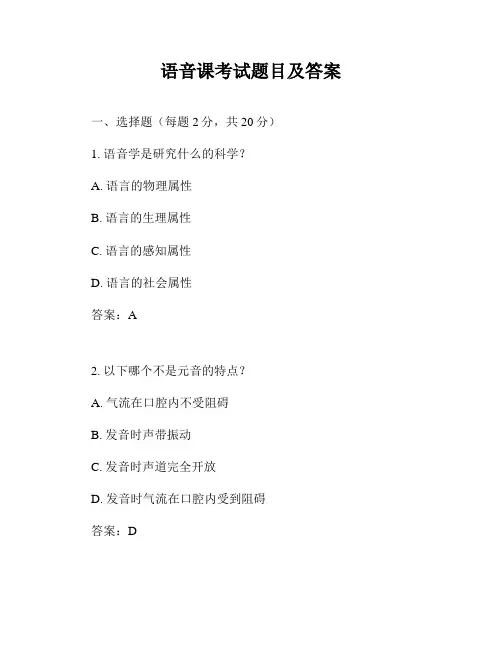
语音课考试题目及答案一、选择题(每题2分,共20分)1. 语音学是研究什么的科学?A. 语言的物理属性B. 语言的生理属性C. 语言的感知属性D. 语言的社会属性答案:A2. 以下哪个不是元音的特点?A. 气流在口腔内不受阻碍B. 发音时声带振动C. 发音时声道完全开放D. 发音时气流在口腔内受到阻碍答案:D3. 辅音的发音特点是?A. 气流在口腔内不受阻碍B. 发音时声带振动C. 发音时声道完全开放D. 发音时气流在口腔内受到阻碍答案:D4. 以下哪个音素是浊音?A. /p/B. /t/C. /k/D. /b/答案:D5. 以下哪个音素是清音?A. /b/B. /d/C. /g/答案:D6. 以下哪个音素是鼻音?A. /m/B. /n/C. /ŋ/D. 所有以上答案:D7. 以下哪个音素是塞音?A. /s/B. /z/C. /p/D. /f/答案:C8. 以下哪个音素是擦音?B. /v/C. /s/D. /ʃ/答案:C9. 以下哪个音素是塞擦音?A. /t/B. /d/C. /ʧ/D. /ʤ/答案:C10. 以下哪个音素是近音?A. /l/B. /r/C. /w/D. /j/答案:B二、填空题(每题2分,共20分)1. 语音学中,________是指声音的高低,由声带的振动频率决定。
答案:音高2. 语音学中,________是指声音的强弱,由声波的振幅决定。
答案:音强3. 语音学中,________是指声音的长短,由声波的持续时间决定。
答案:音长4. 语音学中,________是指声音的清晰度,由声波的频率分布决定。
答案:音质5. 元音的发音特点是气流在口腔内________。
答案:不受阻碍6. 辅音的发音特点是气流在口腔内________。
答案:受到阻碍7. 浊音是指发音时________振动的声音。
答案:声带8. 清音是指发音时________不振动的声音。
答案:声带9. 鼻音是指气流从________流出的声音。
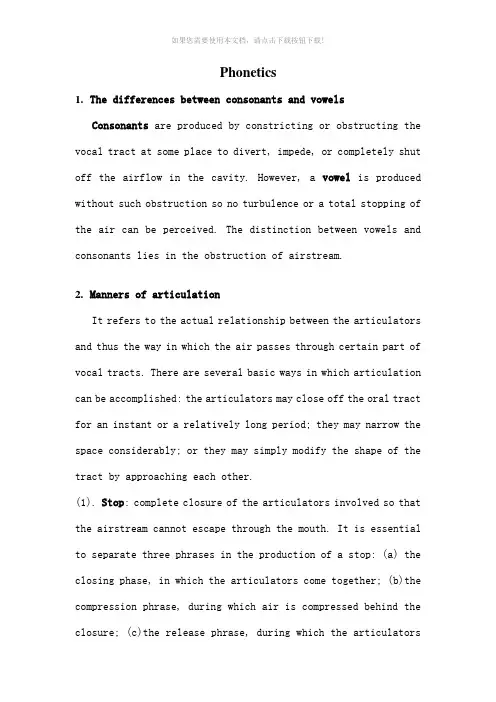
Phonetics1.The differences between consonants and vowelsConsonants are produced by constricting or obstructing the vocal tract at some place to divert, impede, or completely shut off the airflow in the cavity. However, a vowel is produced without such obstruction so no turbulence or a total stopping of the air can be perceived. The distinction between vowels and consonants lies in the obstruction of airstream.2.Manners of articulationIt refers to the actual relationship between the articulators and thus the way in which the air passes through certain part of vocal tracts. There are several basic ways in which articulation can be accomplished: the articulators may close off the oral tract for an instant or a relatively long period; they may narrow the space considerably; or they may simply modify the shape of the tract by approaching each other.(1). Stop: complete closure of the articulators involved so that the airstream cannot escape through the mouth. It is essential to separate three phrases in the production of a stop: (a) the closing phase, in which the articulators come together; (b)the compression phrase, during which air is compressed behind the closure; (c)the release phrase, during which the articulatorsforming the obstruction come rapidly apart and the air is suddenly released.In English, [p, b, t, d, k, g]are stops and[m, n,ŋ]are nasals.(2) Fricative: close approximation of two articulators so that the airstream is partially obstructed and turbulent airflow is produced. In English, [f, v, θ, ð, s, z, ʃ, ʒ, h]are fricatives.(3)Approximant: an articulation in which one articulator is close to another, but without the vocal tract being narrowed to such an extent that a turbulent airstream is produced. The gap between the articulators is therefore larger than for a fricative and no turbulence is generated. In English, this class of sounds includes [w, r, j].(4)Lateral: obstruction of the airstream at a pint along the center of the oral tract, with incomplete closure between one or both sides of the tongue and the roof of the mouth. [l] is the only lateral in English.(5)Trill: produced when an articulator is set vibrating by the airstream. A major trill sound is [r], as in red.(6)Affricates: involving more than one of these manners of articulation in that they consist of a stop followed immediately afterwards by a fricative at the same place of articulation. InEnglish, the “ch [ tʃ ]” of cheese and the “j [dʒ]”of jet are both affricates.3. Places of articulationIt refers to the point where in the vocal tract there is approximation, narrowing or the abstraction of air. Practically, consonants may be produced at any place between the tips and the vocal folds.(1)Bilabial: made with the two lips. In English, bilabial sounds include [p, b, m, w], as in pet, bet, met and wet.(2)Labiodental: made with the lower lip and the upper front teeth. Labiodental sounds include [f, v], as in fire and five.(3)Dental: made by the tongue tip and the upper front teeth. Only frictives[θ, ð] are dental sounds.(4)Alveolar: made with the tongue tip and the alveolar ridge. Sounds include [t, d, n, s, z, r, l] for English.(5)Postalveolar: made with the tongue tip and the back of the alveolar ridge. Such sounds include[ʃ, ʒ,], as in ship and pleasure.(6)Patatal: made with the front to the tongue and the hard palate. The only English sound made here is [j], as in yes and yet. (7)Velar: made with the black of the tongue and the soft palate. Examples in English are velar stops [k, g], as in cat and get,and velar nasal[ŋ], as in sing.(8)Glottal: made with the two pieces of vocal folds pushed towards each other. The only glottal is [h] in hat and head.4.Description of the consonants (必考)[p] voiceless bilabial stop [b] voiced bilabial stop[s] voiceless alveolar fricative [z] voiced alveolar fricative [m] bilabial nasal; [j] palatal approximant[h] glottal fricative [l] alveolar lateral5. Cardinal VowelsThe cardinal vowels are a set of vowel qualities arbitrarily defined, fixed and unchanging, intended to provide a frame of reference for the description of the actual vowels of existing languages.6. Three types of vowelsAccording to the quality of production, there are 3 types of vowels. The first one is monophthong, whose quality of production is unchangeable movement; the second one is diphthong, whose quality of production is a single change movement; and the last one is triphthong, whose quality of production is 2 change movements, such as tower /ˈtaʊə(r)/.7. 短元音发音是会受到清辅音和浊辅音的影响,后面是浊辅音是元音长;后面是清辅音时,元音短。
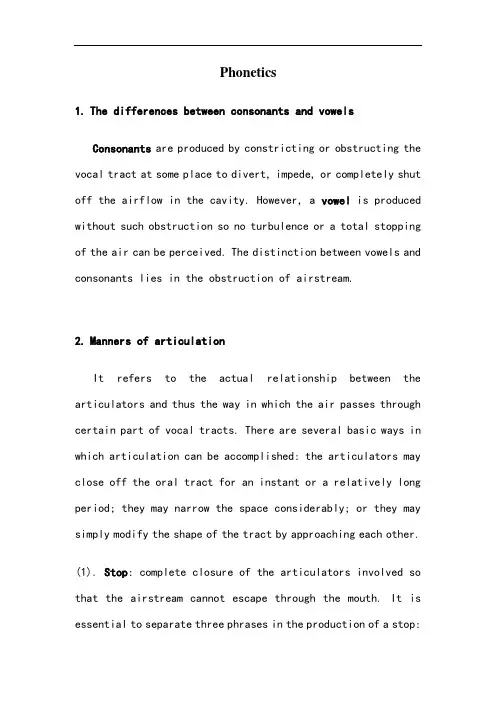
Phonetics1.The differences between consonants and vowelsConsonants are produced by constricting or obstructing the vocal tract at some place to divert, impede, or completely shut off the airflow in the cavity. However, a vowel is produced without such obstruction so no turbulence or a total stopping of the air can be perceived. The distinction between vowels and consonants lies in the obstruction of airstream.2.Manners of articulationIt refers to the actual relationship between the articulators and thus the way in which the air passes through certain part of vocal tracts. There are several basic ways in which articulation can be accomplished: the articulators may close off the oral tract for an instant or a relatively long period; they may narrow the space considerably; or they may simply modify the shape of the tract by approaching each other.(1). Stop: complete closure of the articulators involved so that the airstream cannot escape through the mouth. It is essential to separate three phrases in the production of a stop:(a) the closing phase, in which the articulators come together;(b)the compression phrase, during which air is compressed behind the closure; (c)the release phrase, during which the articulators forming the obstruction come rapidly apart and the air is suddenly released. In English, [p, b, t, d, k, g] are stops and [m, n,?] are nasals.(2)Fricative: close approximation of two articulators so that the airstream is partially obstructed and turbulent airflow is produced. In English, [f, v, θ, e, s, z, ?, ?, h]are fricatives.(3)Approximant: an articulation in which one articulator is close to another, but without the vocal tract being narrowed to such an extent that a turbulent airstream is produced. The gap between the articulators is therefore larger than for a fricative and no turbulence is generated. In English, this class of sounds includes [w, r, j].(4)Lateral: obstruction of the airstream at a pint along the center of the oral tract, with incomplete closure between one or both sides of the tongue and the roof of the mouth. [l] is the only lateral in English.(5)Trill: produced when an articulator is set vibrating by the airstream. A major trill sound is [r], as in red.(6)Affricates: involving more than one of these manners of articulation in that they consist of a stop followed immediately afterwards by a fricative at the same place of articulation. In English, the “ch [ t? ]” of cheese and the “j [d?]”of jet are both affricates.3. Places of articulationIt refers to the point where in the vocal tract there is approximation, narrowing or the abstraction of air. Practically, consonants may be produced at any place between the tips and the vocal folds.(1)Bilabial: made with the two lips. In English, bilabial sounds include [p, b, m, w], as in pet, bet, met and wet. (2)Labiodental: made with the lower lip and the upper front teeth. Labiodental sounds include[f, v], as in fire and five.(3)Dental: made by the tongue tip and the upper front teeth. Only frictives[θ, e] are dental sounds.(4)Alveolar: made with the tongue tip and the alveolar ridge. Sounds include [t, d, n, s, z, r, l] for English.(5)Postalveolar: made with the tongue tip and the back of the alveolar ridge. Such sounds include [?, ?,], as in ship and pleasure.(6)Patatal: made with the front to the tongue and the hard palate. The only English sound made here is [j], as in yes and yet.(7)Velar: made with the black of the tongue and the soft palate. Examples in English are velar stops [k, g], as in cat and get, and velar nasal [?], as in sing.(8)Glottal: made with the two pieces of vocal folds pushed towards each other. The only glottal is [h] in hat and head.4.Description of the consonants (必考)[p] voiceless bilabial stop [b] voiced bilabial stop [s] voiceless alveolar fricative [z] voiced alveolar fricative[m] bilabial nasal; [j] palatal approximant[h] glottal fricative [l] alveolar lateral5. Cardinal VowelsThe cardinal vowels are a set of vowel qualities arbitrarily defined, fixed and unchanging, intended to provide a frame of reference for the description of the actual vowels of existing languages.6. Three types of vowelsAccording to the quality of production, there are 3 types of vowels. The first one is monophthong, whose quality of production is unchangeable movement; the second one is diphthong, whose quality of production is a single change movement; and the last one is triphthong, whose quality of production is 2 change movements, such as tower /?ta??(r)/.7. 短元音发音是会受到清辅音和浊辅音的影响,后面是浊辅音是元音长;后面是清辅音时,元音短。

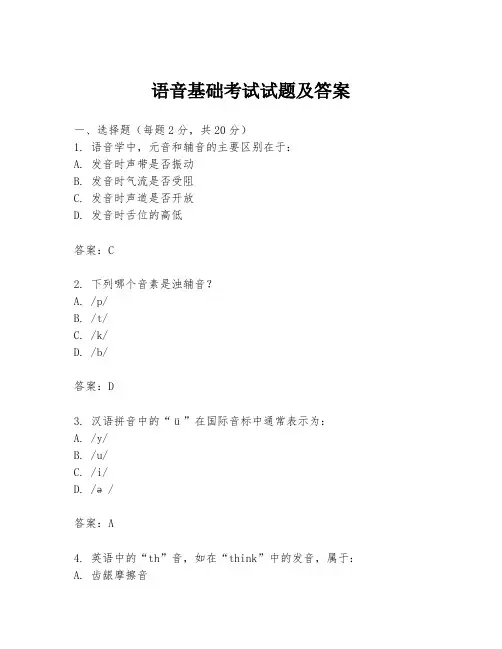
语音基础考试试题及答案一、选择题(每题2分,共20分)1. 语音学中,元音和辅音的主要区别在于:A. 发音时声带是否振动B. 发音时气流是否受阻C. 发音时声道是否开放D. 发音时舌位的高低答案:C2. 下列哪个音素是浊辅音?A. /p/B. /t/C. /k/D. /b/答案:D3. 汉语拼音中的“ü”在国际音标中通常表示为:A. /y/B. /u/C. /i/D. /ə/答案:A4. 英语中的“th”音,如在“think”中的发音,属于:A. 齿龈摩擦音B. 齿龈塞音C. 唇齿摩擦音D. 双唇塞音答案:A5. 汉语普通话中的“四声”是指:A. 四个不同的音节B. 四个不同的声母C. 四个不同的韵母D. 四个不同的声调答案:D6. 英语中的“h”音,如在“hat”中的发音,属于:A. 唇音B. 齿音C. 喉音D. 齿龈音答案:C7. 汉语拼音中的“zh”、“ch”、“sh”分别对应国际音标的哪些音素?A. /ʒ/, /ʧ/, /ʃ/B. /ʃ/, /ʧ/, /ʒ/C. /ʧ/, /ʃ/, /ʒ/D. /ʒ/, /ʃ/, /ʧ/答案:C8. 英语中的“r”音,如在“red”中的发音,属于:A. 齿龈颤音B. 齿龈近音C. 齿龈塞音D. 齿龈擦音答案:A9. 汉语拼音中的“i”在不同的音节中可以表示不同的音素,例如在“机”和“西”中分别表示:A. /i/ 和 /ɪ/B. /ɪ/ 和 /i/C. /i/ 和 /ɪ/D. /ɪ/ 和 /ɪ/答案:C10. 英语中的“ng”音,如在“sing”中的发音,属于:A. 齿龈塞音B. 齿龈擦音C. 软腭塞音D. 软腭擦音答案:C二、填空题(每题2分,共20分)1. 汉语普通话中的“啊”字在不同的语境下可以有四种不同的声调,分别是:________、________、________、________。
答案:阴平、阳平、上声、去声2. 英语中的“l”音,如在“love”中的发音,属于齿龈音,具体是齿龈________音。
![(完整word版)语言学教程[第二章语音]山东大学期末考试知识点复习](https://uimg.taocdn.com/06bbfb6d71fe910ef02df8c6.webp)
第二章语音复习笔记I.语音学和音系学的定义1.语音学语音学研究语音的发生、传递和感知。
2.语音学研究的三大领域(1)发音语言学研究语音的发生。
(2)声学语音学研究语音的物质特征。
(3)感知语音学(或听觉语音学)研究语音的感知。
3.音系学音系学研究的是语言的语音系统。
换句话说,音系学研究的是说话人为表达意义而系统地选择语音的方法。
Ⅱ.发音器官1.发音器官是人体参与语音发生的那部分,包括肺、气管、喉、鼻和口。
2.清音在发音过程中,发音时声带不振动,这样所发出的音叫做清音。
3.浊音在发音过程中,发音时声带振动,这样所发出的音叫做浊音。
4.国际音标(1)国际音标是一个标准的、被国际上广泛接受的语音描述系统。
(2)它的基本原则是用不同的字母符号来表示不同的发音.(3)经过几次修正,目前国际音标仍然被语音学家和语言学家广泛使用.Ⅲ.辅音和元音1.定义(1)发音时,声道的某些部位受到压缩或阻碍后,使得气流在口腔里转向、受阻或完全被阻塞,由此产生的音叫做辅音。
(2)发音时,声道不受任何压缩或阻碍,因此不会有气流的紊乱或停滞,由此产生的音叫做元音。
2.辅音(1)发音方式和发音部位①发音方式指发音器官之间的关系,以及气流经过声道的某些部位时的方式。
②发音部位指声道的哪些部位发生气流摩擦、狭窄化或阻碍.(2)辅音的分类①按发音方式分类,辅音可分为爆破音、鼻音、擦音、近音、边音、颤音、触音和闪音以及塞擦音。
爆破音:[p,b,t,d,k,g]鼻音:[m,n,n]擦音:[f,v,o,6,s,z,J,3,h]近音:[w,J,j]边音:[l]颤音:[ts,dz,tr,dr]②按发音部位分类,辅音可分为双唇音、唇齿音、齿音、齿龈音、齿龈后音、卷舌音、硬腭音、软腭音、小舌音、咽音和声门音。
双唇音:[p,b,m]唇齿音:[f,v]齿音:[0,6]齿龈音:[t,d,n,s,z,j,l]齿音后音:[f,3]硬腭音:[j]软腭音:[k,g,n]声门音:[h]3.元音(1)基本元音基本元音是指一系列约定俗成的、固定不变的元音特质,目的是为语言中实际存在的元音描述提供一个参照框架。

语音学和音系学考试资料Phonetics1.The differences between consonants and vowelsConsonants are produced by constricting or obstructing the vocal tract at some place to divert, impede, or completely shut off the airflow in the cavity. However, a vowel is produced without such obstruction so no turbulence or a total stopping of the air can be perceived. The distinction between vowels and consonants lies in the obstruction of airstream.2.Manners of articulationIt refers to the actual relationship between the articulators and thus the way in which the air passes through certain part of vocal tracts. There are several basic ways in which articulation can be accomplished: the articulators may close off the oral tract for an instant or a relatively long period; they may narrow the space considerably; or they may simply modify the shape of the tract by approaching each other.(1). Stop: complete closure of the articulators involved so that the airstream cannot escape through the mouth. It is essential to separate three phrases in the production of a stop: (a) the closing phase, in which the articulators come together; (b)the compression phrase, during which air is compressed behind the closure; (c)the release phrase, during which the articulators forming the obstruction come rapidly apart and the air is suddenly released. In English, [p, b, t, d, k, g] are stops and [m, n,ŋ] are nasals.(2) Fricative: close approximation of two articulators so that the airstream is partially obstructed and turbulent airflow is produced. In English, [f, v, θ, ð, s, z, ʃ, ʒ, h] are fricatives.(3)Approximant: an articulation in which one articulator is close to another, but without the vocal tract being narrowed to such an extent that a turbulent airstream is produced. The gap between the articulators is therefore larger than for a fricative and no turbulence is generated. In English, this class of sounds includes [w, r, j].(4)Lateral: obstruction of the airstream at a pint along the center of the oral tract, with incomplete closure between one or both sides of the tongue and the roof of the mouth. [l] is the only lateral in English.(5)Trill: produced when an articulator is set vibrating by the airstream. A major trill sound is [r], as in red.(6)Affricates: involving more than one of these manners of articulation in that they consist of a stop followed immediately afterwards by a fricative at the same place of articulation. In English, the “ch [ tʃ ]” of cheese and the “j [dʒ]”of jet are both affricates.3. Places of articulationIt refers to the point where in the vocal tract there is approximation, narrowing or the abstraction of air. Practically, consonants may be produced at any place between the tips and the vocal folds.(1)Bilabial: made with the two lips. In English, bilabial sounds include [p, b, m, w], as in pet, bet, met and wet.(2)Labiodental: made with the lower lip and the upper front teeth. Labiodental sounds include [f, v], as in fire and five.(3)Dental: made by the tongue tip and the upper front teeth. Only frictives [θ, ð] are dental sounds.(4)Alveolar: made with the tongue tip and the alveolar ridge. Sounds include [t, d, n, s, z, r, l] for English.(5)Postalveolar: made with the tongue tip and the back of the alveolar ridge. Such sounds include [ʃ, ʒ,], as in ship and pleasure.(6)Patatal: made with the front to the tongue and the hard palate. The only English sound made here is [j], as in yes and yet.(7)Velar: made with the black of the tongue and the soft palate. Examples in English are velar stops [k, g], as in cat and get, and velar nasal [ŋ], as in sing.(8)Glottal: made with the two pieces of vocal folds pushed towards each other. The only glottal is [h] in hat and head.4.Description of the consonants (必考)[p] voiceless bilabial stop [b] voiced bilabial stop[s] voiceless alveolar fricative [z] voiced alveolar fricative[m] bilabial nasal; [j] palatal approximant[h] glottal fricative [l] alveolar lateral5. Cardinal VowelsThe cardinal vowels are a set of vowel qualities arbitrarily defined, fixed and unchanging, intended to provide a frame of reference for the description of the actual vowels of existing languages.6. Three types of vowelsAccording to the quality of production, there are 3 types of vowels. The first one is monophthong, whose quality of production is unchangeable movement; the second one is diphthong, whose quality of production is a single change movement; and the last one is triphthong, whose quality of production is 2 change movements, such as tower /ˈtaʊə(r)/.7. 短元音发音是会受到清辅音和浊辅音的影响,后面是浊辅音是元音长;后面是清辅音时,元音短。
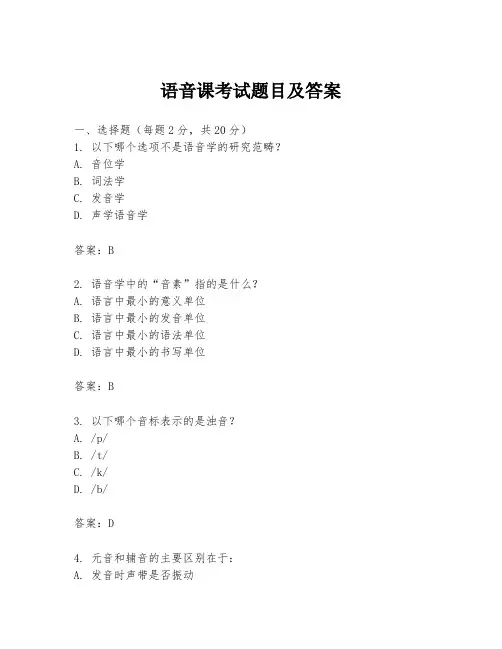
语音课考试题目及答案一、选择题(每题2分,共20分)1. 以下哪个选项不是语音学的研究范畴?A. 音位学B. 词法学C. 发音学D. 声学语音学答案:B2. 语音学中的“音素”指的是什么?A. 语言中最小的意义单位B. 语言中最小的发音单位C. 语言中最小的语法单位D. 语言中最小的书写单位答案:B3. 以下哪个音标表示的是浊音?A. /p/B. /t/C. /k/D. /b/答案:D4. 元音和辅音的主要区别在于:A. 发音时声带是否振动B. 发音时气流是否受阻C. 发音时舌位的高低D. 发音时唇形的圆展答案:A5. 在国际音标中,表示前元音的符号是:A. /i/B. /u/C. /a/D. /e/答案:A6. 下列哪种语言属于声调语言?A. 英语B. 法语C. 汉语D. 德语答案:C7. 以下哪个选项是正确的音节结构?A. CVB. VCC. CVCD. VCV答案:C8. 语音学中,“同位异音”指的是:A. 相同发音位置的两个不同音素B. 相同发音方法的两个不同音素C. 相同发音方式的两个不同音素D. 相同发音效果的两个不同音素答案:D9. 以下哪个选项不是音位变体?A. 自由变体B. 条件变体C. 互补变体D. 语音变体答案:D10. 语音学中,“音位”的概念是由谁提出的?A. 费尔迪南·德·索绪尔B. 诺姆·乔姆斯基C. 列夫·维果茨基D. 丹尼尔·琼斯答案:D二、填空题(每题2分,共20分)1. 语音学是研究______和______的科学。
答案:语音的产生、传播和感知2. 音素的分类包括______、______和______。
答案:元音、辅音、半元音3. 声调是指音高在______上的相对变化。
答案:音节4. 辅音的发音特点是气流在口腔或喉部受到______。
答案:阻碍5. 元音的发音特点是声带振动且气流在口腔内______。
答案:不受阻碍6. 音位变体是指在______中,发音相近或相同,但在意义上______的音素。

Phonetics1.The differences between consonants and vowelsConsonants are produced by constricting or obstructing the vocal tract at some place to divert, impede, or completely shut off the airflow in the cavity、However, a vowel is produced without such obstruction so noturbulence or a total stopping of the air can be perceived、The distinctionbetween vowels and consonants lies in the obstruction of airstream、2.Manners of articulationIt refers to the actual relationship between the articulators and thus the way in which the air passes through certain part of vocal tracts、There are several basic ways in which articulation can be accomplished: the articulators may close off the oral tract for an instant or a relatively long period; they may narrow the space considerably; or they may simply modify the shape of the tract by approaching each other、(1)、Stop: complete closure of the articulators involved so that theairstream cannot escape through the mouth、It is essential to separate three phrases in the production of a stop: (a) the closing phase, in which the articulators come together; (b)the compression phrase, during which air is compressed behind the closure; (c)the release phrase, during which the articulators forming the obstruction come rapidly apart and the air is suddenly released、In English, [p, b, t, d, k, g] are stops and [m, n,ŋ] arenasals、(2) Fricative: close approximation of two articulators so that the airstream is partially obstructed and turbulent airflow is produced、In English, [f, v, θ, ð, s, z, ʃ, ʒ, h] are fricatives、(3)Approximant: an articulation in which one articulator is close to another, but without the vocal tract being narrowed to such an extent that a turbulent airstream is produced、The gap between the articulators is therefore largerthan for a fricative and no turbulence is generated、In English, this class ofsounds includes [w, r, j]、(4)Lateral: obstruction of the airstream at a pint along the center of the oral tract, with incomplete closure between one or both sides of the tongue and the roof of the mouth、[l] is the only lateral in English、(5)Trill: produced when an articulator is set vibrating by the airstream、Amajor trill sound is [r], as in red、(6)Affricates: involving more than one of these manners of articulation in that they consist of a stop followed immediately afterwards by a fricative at the same place of articulation、In English, the “ch [ tʃ ]” of cheese and the“j [dʒ]”of jet are both affricates、3、Places of articulationIt refers to the point where in the vocal tract there is approximation, narrowing or the abstraction of air、Practically, consonants may be produced at any place between the tips and the vocal folds、(1)Bilabial: made with the two lips、In English, bilabial sounds include [p,b, m, w], as in pet, bet, met and wet、(2)Labiodental: made with the lower lip and the upper front teeth、Labiodental sounds include [f, v], as in fire and five、(3)Dental: made by the tongue tip and the upper front teeth、Only frictives[θ, ð] are dental sounds、(4)Alveolar: made with the tongue tip and the alveolar ridge、Soundsinclude [t, d, n, s, z, r, l] for English、(5)Postalveolar: made with the tongue tip and the back of the alveolar ridge、Such sounds include [ʃ, ʒ,], as in ship and pleasure、(6)Patatal: made with the front to the tongue and the hard palate、The onlyEnglish sound made here is [j], as in yes and yet、(7)Velar: made with the black of the tongue and the soft palate、Examples in English are velar stops [k, g], as in cat and get, and velar nasal [ŋ], as in sing、(8)Glottal: made with the two pieces of vocal folds pushed towards each other、The only glottal is [h] in hat and head、4.Description of the consonants (必考)[p] voiceless bilabial stop [b] voiced bilabial stop[s] voiceless alveolar fricative [z] voiced alveolar fricative[m] bilabial nasal; [j] palatal approximant[h] glottal fricative [l] alveolar lateral5、Cardinal VowelsThe cardinal vowels are a set of vowel qualities arbitrarily defined, fixed and unchanging, intended to provide a frame of reference for the description of the actual vowels of existing languages、6、Three types of vowelsAccording to the quality of production, there are 3 types of vowels、The first one is monophthong, whose quality of production is unchangeable movement; the second one is diphthong, whose quality of production is a single change movement; and the last one is triphthong, whose quality ofproduction is 2 change movements, such as tower /ˈtaʊə(r)/、7、短元音发音就是会受到清辅音与浊辅音得影响,后面就是浊辅音就是元音长;后面就是清辅音时,元音短。
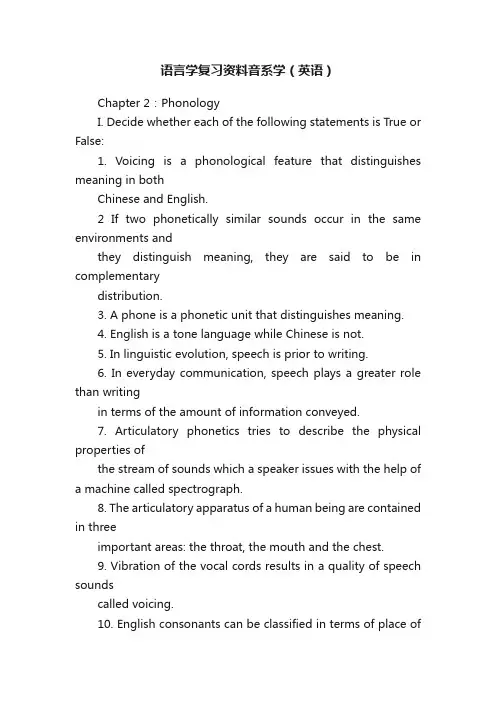
语言学复习资料音系学(英语)Chapter 2:PhonologyI. Decide whether each of the following statements is True or False:1. Voicing is a phonological feature that distinguishes meaning in bothChinese and English.2 If two phonetically similar sounds occur in the same environments andthey distinguish meaning, they are said to be in complementarydistribution.3. A phone is a phonetic unit that distinguishes meaning.4. English is a tone language while Chinese is not.5. In linguistic evolution, speech is prior to writing.6. In everyday communication, speech plays a greater role than writingin terms of the amount of information conveyed.7. Articulatory phonetics tries to describe the physical properties ofthe stream of sounds which a speaker issues with the help ofa machine called spectrograph.8. The articulatory apparatus of a human being are contained in threeimportant areas: the throat, the mouth and the chest.9. Vibration of the vocal cords results in a quality of speech soundscalled voicing.10. English consonants can be classified in terms of place ofarticulationand the part of the tongue that is raised the highest.11. According to the manner of articulation, some of the types intowhich the consonants can be classified are stops, fricatives, bilabial and alveolar.12. Vowel sounds can be differentiated by a number of factors: theposition of tongue in the mouth, the openness of the mouth, the shape of the lips, and the length of the vowels.13. According to the shape of the lips, vowels can be classified intoclose vowels, semi-close vowels, semi-open vowels and open vowels.14. Any sound produced by a human being is a phoneme.15. Phones are the sounds that can distinguish meaning.16. Phonology is concerned with how the sounds can be classified intodifferent categories.17. A basic way to determine the phonemes of a language is to see ifsubstituting one sound for another results in a change of meaning.18. When two different forms are identical in every way except for onesound segment which occurs in the same place in the strings, the two words are said to form a phonemic contrast.19. The rules governing the phonological patterning are languagespecific.20. Distinctive features of sound segments can be found running overa sequence of two or more phonemic segments.II. Fill in each of the following blanks with one word which begins with the letter given:21. A ____ refers to a strong puff of air stream in the production of speech sounds.22.A___________ phonetics describes the way our speech organs work to produce the speech sounds and how they differ.23. The four sounds /p/,/b/,/m/ and /w/ have one feature in common, i.e,they are all b_______ sounds.24. Of all the speech organs, the t ____ is the most flexible, and is responsible for varieties of articulation than any other. 25. English consonants can be classified in terms of manner of articulation or in terms of p_______ of articulation.26. When the obstruction created by the speech organs is total or complete, the speech sound produced with the obstruction audibly released and the air passing out again is called a s________. 27.S_________ features are the phonemic features that occur above the level of the segments. They include stress, tone, intonation, etc. 28.The rules that govern the combination of sounds in a particular lan-guage are called s ____ rules.29. The transcription of speech sounds with letter-symbols only is called broad transcription while the transcription with letter-symbolstogether with the diacritics is called n_________ transcription. 30. When pitch, stress and sound length are tied to the sentence rather than the word in isolation, they are collectively known asi_________.31.P___________ is a discipline which studies the system of sounds ofa particular language and how sounds are combined into meaningfulunits to effect linguistic communication.32.The articulatory apparatus of a human being are contained in three important cavities: the pharyngeal cavity, the o_______ cavity and the nasal cavity.33. T_______ are pitch variations, which are caused by the differing rates of vibration of the vocal cords and which can distinguish meaning just like phonemes.34. Depending on the context in which stress is considered, there are two kinds of stress: word stress and s_________ stress.III. There are four choices following each of the statements below. Mark the choice that can best complete the statement: 35. Of all the speech organs, the _______ is/ are the most flexible.A. mouthB. lipsC. tongueD. vocal cords36.The sounds produced without the vocal cords vibrating are ____ sounds.A. voicelessB. voicedC. vowelD. consonantal37.__________ is a voiced alveolar stop.A. /z/C. /k/D./b/38.The assimilation rule assimilate s one sound to another by “copying”a feature of a sequential phoneme, thus making the two phones____________.A. identicalB. sameC. exactly alikeD. similar39. Since /p/ and /b/ are phonetically similar, occur in the same environments and they can distinguish meaning, they are said to be ___________.A. in phonemic contrastB. in complementary distributionC. the allophonesD. minimal pair40. The sound /f/ is _________________.A. voiced palatal affricateB. voiced alveolar stopC. voiceless velar fricativeD. voiceless labiodentalfricative41. A ____ vowel is one that is produced with the front part of the tonguemaintaining the highest position.A. backB. centralD. middle42. Distinctive features can be found running over a sequence of two ormore phonemic segments. The phonemic features that occur above thelevel of the segments are called ____________.A. phonetic componentsB. immediate constituentsC. suprasegmental featuresD. semanticfeatures43. A(n) ___________ is a unit that is of distinctive value. It is anabstract unit, a collection of distinctive phonetic features.A. phoneB. soundC. allophoneD. phoneme44. The different phones which can represent a phoneme in different phonetic environments are called the ____ of that phoneme.A. phonesB. soundsC. phonemesD. allophonesIV. Define the terms below:45. phonology 46. phoneme 47.allophone 48. internationalphonetic alphabet 49. intonation 50. phonetics 51. auditory phonetics 52. acoustic phonetics 53. phone 54. phonemic contrast 55. tone 56. minimal pairV. Answer the following questions as comprehensively as possible. Give examples for illustration if necessary:57. Of the two media of language, why do you think speech is more basicthan writing?58. What are the criteria that a linguist uses in classifying vowels?59. What are the major differences between phonology and phonetics?60. Illustrate with examples how suprasegmental features can affectmeaning.61. In what way can we determine whether a phone is a phoneme or not?I. Decide whether each of the following statements is True or False:l.T 2.F 3.F 4.F 5.T 6.T 7.F 8.F 9.T10.F11.F 12.T 13.F 14.F 15.F 16. F 17. T 18. F 19. T20. TII. Fill in each of the following blanks with one word which begins with the letter given:21. Aspiration 22.Articulatory 23. bilabial 24. tongue 25.place26. stop 27. Suprasegmental 28. sequential 29. narrow 30. intonation31. Phonology 32. oral 33. Tone 34. sentenceIII. There are four choices following each of the statements below. Markthe choice that can best complete the statement:35.C 36.A 37.B 38.D 39.A 40.D 41.C 42.C 43.D44.DIV. Define the terms below:45. phonology: Phonology studies the system of sounds of a particularlanguage; it aims to discover how speech sounds in a language form patterns and how these sounds are used to convey meaning in linguistic communication.46. phoneme: The basic unit in phonology is called phoneme; it is a unitof distinctive value. But it is an abstract unit. To be exact, a phoneme is not a sound; it is a collection of distinctive phonetic features.47. allophone: The different phones which can represent a phoneme indifferent phonetic environments are called the allophones of that phoneme.48. international phonetic alphabet: It is a standardized andinternationally accepted system of phonetic transcription.49. intonation: When pitch, stress and sound length are tied to thesentence rather than the word in isolation, they are collectively known as intonation.50. phonetics: Phonetics is defined as the study of the phonic medium oflanguage; it is concerned with all the sounds that occur in the world' s languages51. auditory phonetics: It studies the speech sounds from the hearer'spoint of view. It studies how the sounds are perceived by thehearer.52. acoustic phonetics: It studies the speech sounds by looking at thesound waves. It studies the physical means by which speech sounds are transmitted through the air from one person to another.53. phone : Phones can be simply defined as the speech sounds we use whenspeaking a language. A phone is a phonetic unit or segment. It does not necessarily distinguish meaning.54. phonemic contrast: Phonemic contrast refers to the relation betweentwo phonemes. If two phonemes can occur in the same environment and distinguish meaning, they are in phonemic contrast.55. tone: T ones are pitch variations, which are caused by the differingrates of vibration of the vocal cords.56. minimal pair: When two different forms are identical in every wayexcept for one sound segment which occurs in the same place in the strings, the two words are said to form a minimal pair.V. Answer the following questions as comprehensively as possible. Give examples for illustration if necessary:57. Of the two media of language, why do you think speech is more basicthan writing?1) In linguistic evolution, speech is prior to writing.2) In everyday communication, speech plays a greater role thanwriting in terms of the amount of information conveyed.3) Speech is always the way in which every native speaker acquireshis mother tongue, and writing is learned and taught later at school.58. What are the criteria that a linguist uses in classifying vowels?1) Vowels may be distinguished as front, central and back in termsof the position of the tongue in the mouth.2) According to how wide our mouth is opened, we classify thevowels into four groups: close vowels, semi-close vowels, semi-open vowels, and open vowels.3) According to the shape of the lips, vowels are divided intorounded vowels and unrounded vowels.4) The English vowels can also be classified into long vowels andshort vowels according to the length of the sound.59. What are the major differences between phonology and phonetics? They differ in their approach and focus. Phonetics is of a general nature; it is interested in all the speech sounds used in all human languages: how they are produced, how they differ from each other, what phonetic features they possess, how they can be classified. Phonology, on the other hand, is interested in the system of sounds of a particular language; it aims to discover how speech sounds in a language form patterns and how these sounds are used to convey meaning in linguistic communication.60. Illustrate with examples how suprasegmental features can affectmeaning.1) The location of stress in English distinguishes meaning, suchas `import and im`port. The similar alternation of stress also occurs between a compound noun and a phrase consisting of the same elements. A phonological feature of the English compounds, is that the stress of the word always falls on the first element and the second element receives secondary stress, for example: `blackbird is a particular kind of bird, which is not necessarily black, buta black `bird is a bird that is black.2) The more important words such as nouns, verbs adjectives ,adverbs,etc are pronounced with greater force and made more prominent. But to give special emphasis to a certain notion, a word in sentence that is usually unstressed can be stressed to achieve different effect. Take the sentence “He is driving my car.” for example. To emphasize the fact that the car he is driving is not his, or yours, but mine, the speaker can stress the possessive pronoun my, which under normal circumstances is not stressed.3) English has four basic types of intonation, known as the fourtones: When spoken in different tones, the same sequence of words may have different meanings. Generally speaking, the falling tone indicates that what is said is a straight-forward, matter-of-fact statement, the rising tone often makes a question of what is said, and the fall-rise tone often indicates that there is an implied message in what is said.61. In what way can we determine whether a phone is a phoneme or not?A basic way to determine the phonemes of a language is to see ifsubstituting one sound for another results in a change of meaning. If it does, the two sounds then represent different phonemes.。
第三章 语音和音系【内容简介及重点】本章主要论及语言符号系统中的第一层:语音系统的结构组织及表现形式。
主要理解语音的物理属性、生理属性,这是语言的自然属性;从区分语言单位的角度看语音的社会属性,国际音标及国际音标发音原理,音位的划分原理、音位的组合。
第一节语音和音系的区别与联系一语音学和音系学1.1 语音的属性语音及其与非语音的区别。
1.2 语音学Phonetics,语音学,研究人类发音特点,特别是语音发音特点,并提出各种语音描写、分类和转写方法的科学。
1.2.1 言语的传递过程大致分为三个阶段:发音——声波——听觉1.2.2 根据言语传递的三个不同阶段,语音学一般有三个分支:发音语音学(articulatory phonetics)、声学语音学(acoustic phonetics)、听觉语音学(auditory phonetics)或心理语言学(psycholinguistics)。
1.2.3 语音学的各种范畴一般用源自其他学科的术语来定义,如解剖学、生理学和声学。
1.3 音系学1.3.1 Phonology,音系学,语言学研究语音系统的分支。
人类发音器官所能发出的、并由语音学研究的各种各样的音中,每种语言只区别性的利用其中很小一部分。
这些音被组织成一个各种对立的系统,根据不同的理论用音位、区别特征或其他这类“音系单位”加以分析。
1.3.2 各种语言学理论对音系学持两种主要观点中的一种:(a)视为语言组织的一个平面,首先与语音学、语法学和语义学相对立;(b)视为生成语法的一个组成部分(音系部分phonological component),与其他各个组成部分(早期生成语法是句法部分和语义部分;最简方案是隐性部分)相对立。
音系学内部通常有两个研究分支:音段音系学(segmental phonology)和超音段音系学(suprasegmental phonology)。
前者将言语分析成离散的音段,如音位;后者也叫非音段音系学(non-segmental phonology),分析那些超越一个音段的特性,如语调曲拱。
语言学音系学试题及答案一、选择题(每题2分,共20分)1. 音系学是研究语言中的什么现象?A. 语法结构B. 词汇意义C. 语音系统D. 语用功能答案:C2. 以下哪个术语是描述音位的最小对立单位?A. 音素B. 音节C. 音位D. 音标答案:A3. 在音系学中,同位异音指的是什么?A. 同一个音位的不同发音B. 不同音位的相同发音C. 同一个词的不同发音D. 不同词的相同发音答案:A4. 音系规则是什么?A. 描述音位之间关系的规则B. 描述词义之间关系的规则C. 描述语法结构的规则D. 描述词序的规则答案:A5. 以下哪一项不是音系学的研究对象?A. 音位B. 语调C. 语法D. 音节答案:C二、填空题(每题2分,共20分)1. 音系学中的最小语音单位是________。
答案:音素2. 音系学中的音位变体称为________。
答案:同位异音3. 音系学中的________规则描述了音位之间的系统性关系。
答案:音系4. 音系学中的________现象指的是在不同语境中,同一个音位可以有不同的发音。
答案:互补分布5. 在音系学中,________指的是音位在特定语音环境中的发音变化。
答案:音位变体三、简答题(每题10分,共30分)1. 简述音系学与语音学的区别。
答案:音系学是研究语言中音位的系统性规律,而语音学是研究人类语音的物理属性和发音机制。
2. 描述音位和音素之间的关系。
答案:音素是语音学中的最小单位,而音位是音系学中的最小单位,音位是由一组音素构成的,它们在特定语言中具有相同的功能。
3. 解释什么是音系规则,并给出一个例子。
答案:音系规则是描述音位之间如何相互作用的规则。
例如,在英语中,清音在词末的发音往往会变为浊音,如“cat”和“cats”中的“t”发音不同。
四、论述题(每题30分,共30分)1. 论述音系学在语言习得和教学中的作用。
答案:音系学在语言习得和教学中起着重要作用。
它帮助学习者理解语言的音位系统,从而更好地掌握发音规则。
语言学重点试题及答案1. 什么是语言的双重性质?答案:语言的双重性质指的是语言既是社会现象,又是心理现象。
作为社会现象,语言是人们交流思想、情感的工具,是社会文化的重要组成部分;作为心理现象,语言是人类大脑活动的产物,是思维的载体。
2. 简述语音学与音系学的区别。
答案:语音学是研究人类语音的物理属性、生理机制和感知过程的学科;音系学则是研究语言中音位的系统和规律的学科。
语音学关注的是语音的自然属性,而音系学关注的是语音在特定语言系统中的功能和结构。
3. 请解释“词义”和“语义”的概念。
答案:词义是指词所表达的具体概念或意义;语义则是指语言符号所表达的意义,包括词汇意义、句法意义和语用意义等。
词义通常指单个词的意义,而语义则涉及整个句子或话语的意义。
4. 什么是语言的同源词?答案:同源词是指来自同一原始语源的词,它们在不同语言中保留了相似的词形和意义。
例如,英语中的“mother”和德语中的“Mutter”就是同源词。
5. 请解释“语用学”的概念。
答案:语用学是研究语言使用者在特定语境中如何使用语言进行交流的学科。
它关注的是语言的交际功能,包括言语行为、话语意义、语境分析等。
6. 什么是语言的方言?答案:方言是指在地理、社会或历史因素影响下形成的具有一定差异的语言变体。
方言通常与标准语或官方语言相对,它们在语音、词汇、语法等方面存在差异。
7. 简述语言的演变过程。
答案:语言的演变过程包括语音变化、词汇变化、语法变化等。
语音变化可能涉及音位的替换、合并或分化;词汇变化可能包括新词的产生、旧词的消亡或词义的演变;语法变化可能涉及句法结构的简化或复杂化。
8. 什么是语言的借词?答案:借词是指从一种语言借用到另一种语言的词汇。
借词通常是因为文化、经济或政治交流而产生的,它们可能在新语言中保留原有的发音和拼写,也可能发生适应性的变化。
9. 请解释“语言的谱系分类”。
答案:语言的谱系分类是根据语言之间的亲缘关系对语言进行分类的方法。
语音考试题及答案一、选择题(每题2分,共20分)1. 语音学中,音素是指:A. 语言中最小的意义单位B. 语言中最小的语音单位C. 语言中最小的语法单位D. 语言中最小的书写单位答案:B2. 下列哪个选项中的词语发音完全相同?A. 鱼、雨、语B. 吃、尺、迟C. 书、梳、舒D. 知、支、织答案:A3. 汉语普通话中,声母“j”的发音特点是:A. 舌尖前音B. 舌面音C. 舌尖后音D. 舌根音答案:C4. 汉语拼音中,“ü”的发音与下列哪个元音相似?A. [i]B. [u]C. [e]D. [o]答案:B5. 汉语普通话中,下列哪个声母是浊音?A. bB. pC. mD. f答案:C6. 下列哪个词语的声调标注不正确?A. 妈(mā)B. 麻(má)C. 马(mǎ)D. 骂(mà)答案:B7. 汉语普通话中,轻声的特点是:A. 声调不明显B. 声调与第四声相同C. 声调与第一声相同D. 声调与第二声相同答案:A8. 汉语拼音中,“ng”是:A. 声母B. 韵母C. 声调D. 隔音符号答案:A9. 下列哪个词语的声母是“n”?A. 你B. 了C. 来D. 了答案:A10. 汉语普通话中,下列哪个词语的韵母是“iao”?A. 脚B. 叫C. 教D. 桥答案:C二、填空题(每题2分,共20分)1. 汉语普通话中,声母“z”的发音部位是_________。
答案:舌尖前音2. 汉语拼音中,“ai”的发音与英语中的_________相似。
答案:eye3. 汉语普通话中,声母“f”的发音特点是_________。
答案:唇齿音4. 汉语普通话中,韵母“ie”的发音特点是_________。
答案:前高不圆唇元音5. 汉语普通话中,声母“g”的发音特点是_________。
答案:舌根音6. 汉语拼音中,“ü”的发音与英语中的_________相似。
答案:book7. 汉语普通话中,轻声的调值是_________。
专项语音考试题库及答案一、单选题1. 下列哪个选项是“语音”的正确定义?A. 语言的书面形式B. 语言的口头表达形式C. 语言的非言语表达形式D. 语言的电子形式答案:B2. 语音学是研究什么的学科?A. 语言的语法结构B. 语言的发音和声音C. 语言的词汇和语义D. 语言的社会功能答案:B3. 以下哪个是元音的特点?A. 发音时声带振动B. 发音时气流受阻C. 发音时声道完全开放D. 发音时声道部分受阻答案:C4. 辅音和元音的主要区别是什么?A. 发音时声带是否振动B. 发音时声道是否开放C. 发音时是否需要气流D. 发音时是否清晰答案:B5. 国际音标(IPA)的主要作用是什么?A. 表示单词的拼写B. 表示单词的发音C. 表示单词的意义D. 表示单词的语法功能答案:B二、多选题6. 以下哪些是语音学研究的范畴?A. 音素B. 音节C. 语调D. 语法答案:A, B, C7. 以下哪些是元音的特点?A. 声道完全开放B. 声带振动C. 气流不受阻碍D. 发音时声音响亮答案:A, B, C, D8. 辅音的分类方式有哪些?A. 根据发音部位B. 根据发音方法C. 根据发音时声带是否振动D. 根据音节的位置答案:A, B, C9. 语音的物理属性包括哪些?A. 音高B. 音强C. 音长D. 音色答案:A, B, C, D10. 语音的生理属性包括哪些?A. 呼吸B. 声带C. 口腔D. 鼻腔答案:A, B, C, D三、判断题11. 语音是语言的口头表达形式。
(对)12. 所有元音的发音部位和发音方法都是相同的。
(错)13. 辅音的发音总是伴随着声带振动。
(错)14. 国际音标可以用来表示世界上任何语言的发音。
(对)15. 语音的物理属性包括音高、音强、音长和音色。
(对)四、简答题16. 简述语音学的主要研究内容。
答案:语音学主要研究语言的发音和声音,包括音素的分类、发音方法、发音部位、音节结构、语调、重音以及语音的物理和生理属性等。
《语言学纲要》第三章语音和音系一、名词解释语音四要素——音高、音重(强)、音长、音质。
音素——是从音质的角度划分出来的最小的线性的语音单位音位——具体语言中有区别词的语音形式的作用的最小的语音单位。
也是按语音的辨义作用归纳出来的音类,从语言的社会属性划分出来的语言单位音位变体——处在互补关系中的相似的音素彼此不对立,即不起区别词的语音形式的作用,我们可以把它们归并为一个音位。
如果它们被归并为一个音位,则处于互补关系中的各个音素就被看成为同一音位在不同位置上的代表,是同一个音位的不同的变异形式,所以我们把它们叫做音位变体。
非音质音位——非音质音位指具有区别词的语音形式的作用的音高、音重、音长等。
例如汉语普通话声调中的阴平、阳平、上声、去声,是由音高的变化形成的而不是音质变化形成的,就是非音质音位。
区别特征——具体语言中有区别音位的作用的发音特征,叫做该语言的区别特征。
每一个音位都可以分解为几个不同的区别特征。
运用区别特征比较容易说清楚音位在具体语言中的特点和具体语言语音系统的组织方式。
音节——由音位组成的语音中最小的结构单位,也是从听觉上感受到的最自然的单位。
语流音变——音位和音位组合的时候,由于受说话时快慢,高低、强弱的不同和邻音的影响,可能发生不同的临时性的变化。
这种变化,我们叫做语流音变。
音步——语言的一种节奏中,语流是大致每隔两个音节就有一次小的轻重、高低、长短或松紧的交替,形成语流中大致等距离出现的两音节的节奏单元。
这种节奏单元叫做音步。
二、填空或简答1、画一张元音舌位图,用国际音标标出八个基本元音。
八个基本元音[i][e][ ][a][u][o][ɔ][ɑ]2、按音位特征用国际音标注出相应的音素。
(1)双唇浊鼻音m(2)舌尖前浊擦音z(3)舌面前送气清塞擦音ʨ‘(4)后低不圆唇元音ɑ(5)前半高不圆唇元音e(6)后半高圆唇元音o3、列出现代汉语普通话辅音音位的至少四对区别特征并各举一对儿对立音位。
Phonetics1.The differences between consonants and vowelsConsonants are produced by constricting or obstructing the vocal tract at some place to divert, impede, or completely shut off the airflow in the cavity. However, a vowel is produced without such obstruction so no turbulence or a total stopping of the air can be perceived. The distinction between vowels and consonants lies in the obstruction of airstream.2.Manners of articulationIt refers to the actual relationship between the articulators and thus the way in which the air passes through certain part of vocal tracts. There are several basic ways in which articulation can be accomplished: the articulators may close off the oral tract for an instant or a relatively long period; they may narrow the space considerably; or they may simply modify the shape of the tract by approaching each other.(1). Stop: complete closure of the articulators involved so that the airstream cannot escape through the mouth. It is essential to separate three phrases in the production of a stop: (a) the closing phase, in which the articulators come together; (b)the compression phrase, during which air is compressed behind the closure; (c)the release phrase, during which the articulatorsforming the obstruction come rapidly apart and the air is suddenly released. In English, [p, b, t, d, k, g]are stops and [m, n,ŋ] are nasals.(2) Fricative: close approximation of two articulators so that the airstream is partially obstructed and turbulent airflow is produced. In English, [f, v, θ, ð, s, z, ʃ, ʒ, h]are fricatives.(3)Approximant: an articulation in which one articulator is close to another, but without the vocal tract being narrowed to such an extent that a turbulent airstream is produced. The gap between the articulators is therefore larger than for a fricative and no turbulence is generated. In English, this class of sounds includes [w, r, j].(4)Lateral: obstruction of the airstream at a pint along the center of the oral tract, with incomplete closure between one or both sides of the tongue and the roof of the mouth. [l] is the only lateral in English.(5)Trill: produced when an articulator is set vibrating by the airstream. A major trill sound is [r], as in red.(6)Affricates: involving more than one of these manners of articulation in that they consist of a stop followed immediately afterwards by a fricative at the same place of articulation. In English, the “ch [ tʃ ]” of cheese and the “j [dʒ]”of jetare both affricates.3. Places of articulationIt refers to the point where in the vocal tract there is approximation, narrowing or the abstraction of air. Practically, consonants may be produced at any place between the tips and the vocal folds.(1)Bilabial: made with the two lips. In English, bilabial sounds include [p, b, m, w], as in pet, bet, met and wet.(2)Labiodental: made with the lower lip and the upper front teeth. Labiodental sounds include [f, v], as in fire and five.(3)Dental: made by the tongue tip and the upper front teeth. Only frictives[θ, ð] are dental sounds.(4)Alveolar: made with the tongue tip and the alveolar ridge. Sounds include [t, d, n, s, z, r, l] for English.(5)Postalveolar: made with the tongue tip and the back of the alveolar ridge. Such sounds include [ʃ, ʒ,], as in ship and pleasure.(6)Patatal: made with the front to the tongue and the hard palate. The only English sound made here is [j], as in yes and yet. (7)Velar: made with the black of the tongue and the soft palate. Examples in English are velar stops [k, g], as in cat and get, and velar nasal [ŋ], as in sing.(8)Glottal: made with the two pieces of vocal folds pushed towards each other. The only glottal is [h] in hat and head.4.Description of the consonants (必考)[p] voiceless bilabial stop [b] voiced bilabial stop[s] voiceless alveolar fricative [z] voiced alveolar fricative [m] bilabial nasal; [j] palatal approximant[h] glottal fricative [l] alveolar lateral5. Cardinal VowelsThe cardinal vowels are a set of vowel qualities arbitrarily defined, fixed and unchanging, intended to provide a frame of reference for the description of the actual vowels of existing languages.6. Three types of vowelsAccording to the quality of production, there are 3 types of vowels. The first one is monophthong, whose quality of production is unchangeable movement; the second one is diphthong, whose quality of production is a single change movement; and the last one is triphthong, whose quality of production is 2 change movements, such as tower /ˈtaʊə(r)/.7. 短元音发音是会受到清辅音和浊辅音的影响,后面是浊辅音是元音长;后面是清辅音时,元音短。